VVAM Newsletter 8 – 1982
Vrienden van het Airborne Museum
SOCIETY OF FRIENDS OF THE AIRBORNE MUSEUM OOSTERBEEK
Utrechtseweg 232, 6862 AZ Oosterbeek, Netherlands
Representative in Gr.Britain: Mr.A.Maynard, M.B.E.
49, Glenfarg Road, Catford, London SE6 1XN
Tel.: Ol.698.8969
NEWS-LETTER No. 8. October 1982
Editor: Drs.R.P.G.A.Voskuil Dutch-English translation: S.G.Beek-Hobart
Dear Friends,
As in past years, the month of September was very much marked by the Commemoration of the Battle of Arnhem. There is still a great amount of interest shown in this Commemoration, and in-between the many well-known faces, countless new faces were to be seen during the most moving and so-familiar service. More than thirty veterans returned here for the first time in thirty-eight years, and for many of them it was difficult to recognise the areas in which they had fought in 1944. The passing of time has almost healed the wounds in the landscape. But the memories remain, and though they may become somewhat faded, they will never be forgotten. As new generations grow up who have not gone through this most difficult period, it is important that they too realise that our freedom was fought for with great sacrifices. Not only the Airborne Cemetery and the various monuments, but also the Airborne Museum can contribute towards this.
It is imperative that this remain so, lest we should forget.
Drs.J.Smits, Chairman.
An Afternoon with a Special Theme on the 20th November, including a talk and the showing of films.
On Saturday, 20th November, an Afternoon with a Special Theme will be held in the Concert- Hall at Oosterbeek. The programme will be as follows: 14.00 hrs.: A talk which will be given by Mr.W.Boersma (committee member of the Airborne Museum Foundation) concerning the radio-communications during the Battle of Arnhem. Mr.Boersma will give an overall picture of not only the organisation of the Signal Service of the First British Airborne Division but also of the transmitter-receivers used and the reasons for the failure of the communications. The talk will be illustrated by the use of slides.
15.00 hrs.: An interval of about twenty minutes.
15.20 hrs.: The presentation of an original news-film about the Battle of Arnhem which was shown in the British cinemas in October, 1944.
15.4-0 hrs. : Presentation of a scientifically-based film which was made in 1967 By the Film & Science Foundation in Utrecht. Not only are original shots from 1944 to be seen, but also maps which have been integrated into the film material, showing moving arrows which help to give an impression of the progress of the various battalions during the Battle of Arnhem.
16.30 hrs.: Meeting closes.
News from the Treasurer and the Membership Administration.
You will find an accept-giro card included in this Newsletter for your contribution for I983 (for members in the Netherlands only). We would be most obliged if you could pay this contribution as promptly as possible, which most certainly helps to simplify our work. Immediately after payment, your Membership/Family Card for 1983 will be sent to you. Members planning to attend the Special Afternoon on the 20th November can of course pay
their contribution at the same time and receive their Membership Card. This saves your time and the Society postage costs! Our grateful. thanks for sue , + hp’lst December-
Should you wish to terminate your membership, this should be one needs a healthv
but do think twice about terminating your support for the Museum, which needs ah althy and increasing membership more than ever. You know of course that ha o a tributions go directly to the Museum!
The death of Mr.P.A.Hyatt.
We have just been informed of the death of Mr.P.A.Hyatt of South Coogee, Australia, a member of our Society and Arnhem veteran.
The Society’s sale of souvenirs a great success.
During the Airborne Walk, which took place on 4th September last, the Society of Friends sold souvenirs to a value of more than f 2000.-. A stall was set up in Oosterbeek at the crossroads near to Schoonoord, and Mrs.De Langen, Mrs.Smit, Messrs Hendriks, Smits, De Ruyter and Erik de Ruyter were in attendance. An amount of f 1698.85 was attributable to the sale of Airborne Museum souvenirs. A “sticker” especially designed for the Society by Mr.De Ruyter which was on sale, produced an amount of f 411.15. Over and above this, 13 new members were registered. All in all, a great success.
The gift of a diary.
One of our members, Mr.C. van het Kaar, M.B.E., who was a liaison officer attached to the 43rd Wessex Division, has given his diary to our Society. This diary covers the period from the 14th September 1944 to the 3rd December 1944.
Polish decoration presented at the Airborne Museum.
A short ceremony took place in the Airborne Museum on the 18th September, during which Captain Z.Gasowski, representing the former First Independent Polish Parachute Brigade, presented Polish decorations to four Dutch inhabitants and to four Polish people residing in the Netherlands. A Polish para-badge of gold was presented to the Burgomaster, Jhr.Mr. H.G. van Holthe tot Echten. Silver para-badges were presented to Mrs.A.W.Winkler-Koert, of the “Lest We Forget” Foundation, Mr.W.Boersma of the Airborne Museum Foundation and Mr.A.Baltussen of the Driel-Poland Committee. These special decorations were presented in recognition of the great effort made by the afore-mentioned in the organisation of the annual Airborne Commemoration.
Dr.Lipmann Kessel donates his medals to the Airborne Museum.
Dr.Lipmann Kessel, an English doctor, was one of the many veterans who came to Arnhem this year for the Commemoration. On 19th September, he made a short visit to the Airborne Museum, whereupon he donated his medal-set. In September 1944, Dr.Lipmann Kessel was assigned as a doctor to the 16th Parachute Field Ambulance, and during the Battle of Arnhem he worked in the hospital, St.Elisabeth’s Gasthuis, in Arnhem. After the fighting, he was taken prisoner-of-war and transported to Apeldoom. He managed to escape and was brought to safety by people in the Dutch Resistance. Under his pseudonym “Daniel Paul”, together with John St.John, he published the book entitled, “Surgeon at Arms” in 1958, which appeared in the Netherlands under the title “Een chirurg valt uit de lucht”. Later editions which were reprinted, appeared under his own name.
A unique instrument has been added to the Museum’s collection.
The Airborne Museum has recently come into possession of an extremely special instrument described as a “Horsa 1, C.G. and Weight Determinator” (“C.G.” signifies “Centre of Gra¬vity”). This instrument was used to accurately ascertain the way in which the cargo of a Horsa.glider should be distributed. The instrument itself consists of an aluminium plate in the shape of a longitudinal section of the Horsa, and this plate can be attached to a weighing mechanism. A great number of holes have been drilled into the plate into which metal discs of varying weight can be attached. These weighted discs can be distributed in such a way that a balance is attained. By proportionately distributing the same weight on the cargo in the real Horsa, the glider maintained a good balance during flight Tn fact though, the loading of the Horsa was often done much more simply withort tSfLSuS’
being used. Then the section of the Horsa glider behind the wings was first loaded until the front wheel left the.ground, and consequently the front section was loaded.
This type.o instrument is very rare, and as far as known, the only other example is to be found in the Museum of Army Flying in Middle Wallop in England.
A film about the British Medical Service during the Battle of Arnhem.
During the first.week of October a film-team from “Services Sound & Vision Corporation” of the British Ministry of Defence made film shots for a film about the Medical Service during the Battle of Arnhem. The film-team was assisted and advised by the English doctor Stuart Mawson, who wrote “Arnhem Doctor” (see News-letter No. 6). The film is mostly based on his experiences and accentuates the difficult and frequently chaotic circum¬stances under which the British doctors had to work in Arnhem and Oosterbeek in September 19^4. Most of the hospitals and first-aid posts were on the frontline. More than often there was neither water nor electricity and a shortage of bandages and medicine. The doctors often had to carry out operations with the most primitive resources and continual improvisation. For such young and inexperienced doctors such as Mawson, inadequately prepared to such difficult conditions, this was an extremely heavy mission. The film which is now being made is, indeed, meant to show British doctors who are being trained at the Royal Army Medical School in Aidershot this aspect of their work. The Head of the R.A.M.S., Colonel C.Ticehurst, is acting advisor to this film. Most of the shooting of the film is being done in Hartenstein, near Schoonoord and the Old Church in Oosterbeek, and in St.Elisabeth’s Gasthuis as well as the Hulkesteinseweg in Arnhem.
We hope to be able to show this film in one of our future Special Afternoons.
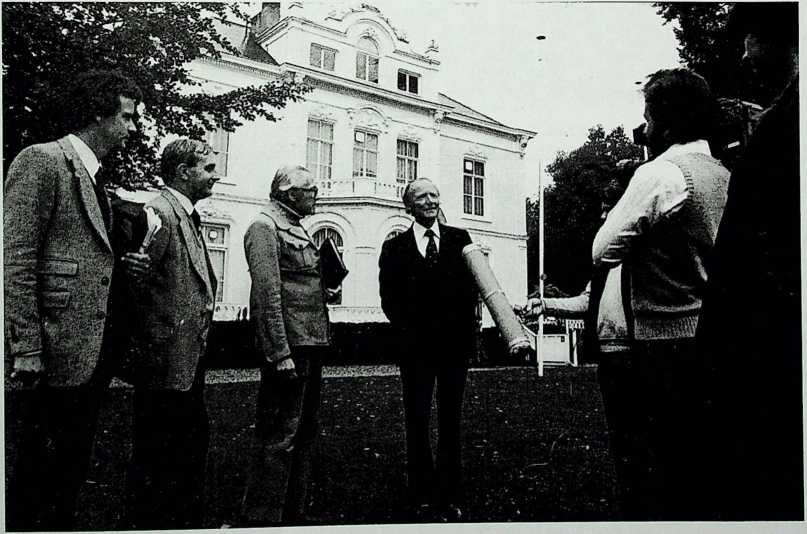
he film-team in action, with Hartenstein in the background.
from left to right • C Wilson (producer), Colonel C.Ticehurst (Head of Training Institute for British Army Doctors), P.Hopkinson (film director), Dr.Stuart Mawson, P.Fumey soundman), T/Paynter (cameraman) and J.Randall (lighting). (Photo: B. de Reus)
Mr E Gerritsen retired on the 1st October as gardener of Hartenstein Park. As far back Egbert Gerritsen assisted in the restoration of the war-damaged park and since g6l was SSmSent gardener. When the Airborne Museum was established in Hartenstein House in 1978, the visitors increased extensively. The great care taken by Egbert Gerritsen in upkeeping the gardens has enabled countless visitors to enjoy this lovely park which is so characteristic of Oosterbeek. We are extremely grateful to him.
Plans for a new “Airborne Museum” in Nijmegen.
In May of this year a foundation came into being called “Stichting Bevrijdingsmuseum 1944” (Foundation of the Museum of Liberation 1944) and its objective is “to establish and maintain an historic museum concerning the liberation in September 1944 of the City of Nijmegen & its surroundings”. This initiative has been taken by a group of veterans of the 82nd Airborne Division, whose unexpected arrival on the 17th September, 1944, started the liberation of this area. A delegation attached to this Association arrived in the Netherlands in September, 1981, to discuss their plans. Organisations relating to the former U.S.Troop Carrier Command announced their support. The Foundation would like to see its objectives attained in the Netherlands, in cooperation with the Airborne Museum in Oosterbeek and the Society of Airborne Friends in Eindhoven. They hope for extensive support both in Nijmegen and elsewhere in order to realise this new Museum.
New publication of the book entitled, “Arnhem September 1944”.
In 1969 the book entitled, “Arnhem September 1944” was published, compiled by Drs.P.R.A. van Iddekinge, who is attached as historian to the Archive Dept, of the Municipality of Arnhem. The book has been sold-out for many years but has now been reprinted. It contains many photographs, and a concise text (both in Dutch and in English) gives a picture of the events which took place in Arnhem and Oosterbeek in September 1944. The book’s main theme is the attempt – which failed – on the 19th September to reach the bridge with a few battalions via Onderlangs and Bovenover. The battle in this area was covered by two German army photographers, who made an extensive series of photographs which came to light in I967 at the “Bundes-Archiv” in Koblenz. These photographs enabled a good picture to be constructed of the actual events of that Tueday in Arnhem. The book has been reprinted by Gysbers & Van Loon in Arnhem and costs f 24.75. The book is also obtainable at the Airborne Museum in Oosterbeek
A new book about the events which took place in the Over-Betuwe, September ’44 – June ’45.
The area between Nijmegen and Arnhem suffered enormous war-damage – very many lives were lost and there was great devastation. The book entitled, “Het Manneneiland” (“Men’s Island”) written by Hen Bollen and Herman Jansen, describes this period.
The book tackles first of all the attempts made by the Allied troops to reach the First British Airborne Division in Arnhem. The fighting which took place at the Waal Bridge is the central theme of the first part of the book, as well as the crossing of the Waal River by the American Parachutists on the 20th September, the account of the first British tanks which managed to cross the Waal Bridge and the baffling reasons why the Waal Bridge failed to be blown-up. When the advance via Elst becomes impossible, the 43rd Wessex Division, after a great deal of difficulties, manages to reach by way of Valburg the Polish parachutists who had landed at Driel on the 21st September. The Polish and troops from the Dorsetshire Regiment then try to strengthen the British, who have become entrapped in Oosterbeek. These attempts have very little success. On the night of the 25th September, the remainder of the British Airborne Division retreats across the Rhine. From that moment onwards, the Germans try to capture the small Allied bridge¬head in the Betuwe. They also make various attempts to destroy the Waal Bridge at Nij¬megen, even using especially trained frogmen and one-man-submarines. However, the vulnerable bridge-head remains in Allied hands.
Life for the civilians becomes untenable, especially when the Germans inundate the Betuwe at the beginning of December. The Allies order that the population be evacuated, and finally only a thousand men remain. Their adventures, life and work in this grim and inundated area is the subject of the rest of the book. “Het Manneneiland” is a publication of “TERRA” in Zutphen, and costs f 39-
News-letter No. 9.
The next News-letter will appear in January, 1983.

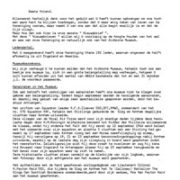
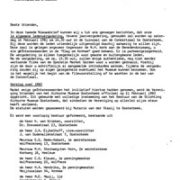
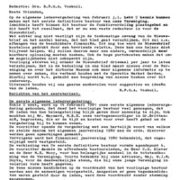
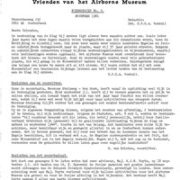
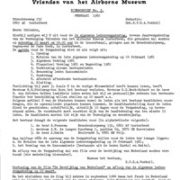
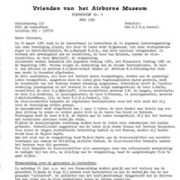
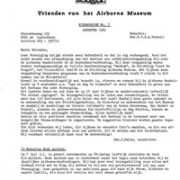
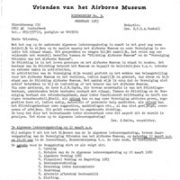


Plaats een Reactie
Vraag of reactie?Laat hier uw reactie achter.